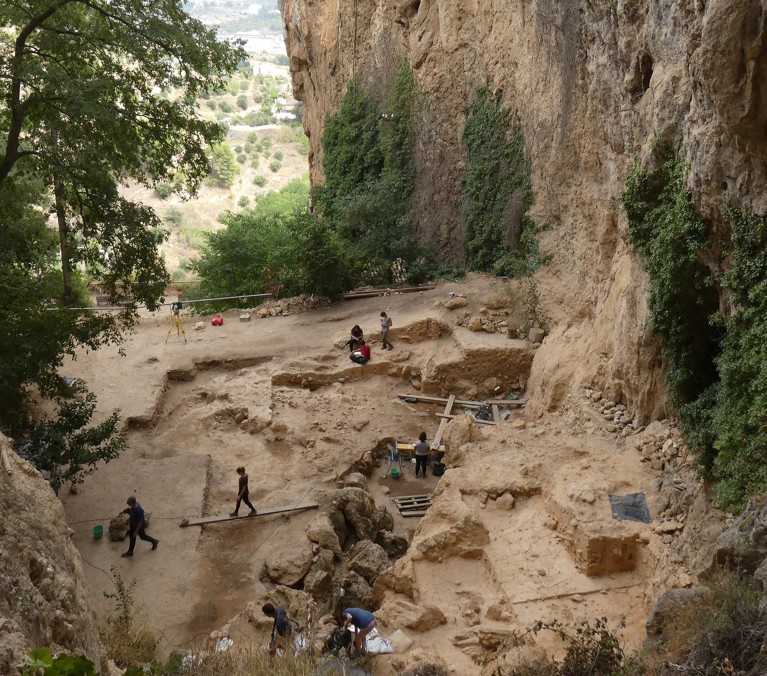Hello Nature readers, would you like to get this Briefing in your inbox free every day? Sign up here.

El Salt, an archaeological site in Spain, which has the remains of several Neanderthal hearths.Credit: University of Bologna
Ancient hearths reveal that generations of Neanderthals regularly visited a rugged river valley in Spain over a period of around 200 years. Previous work estimated that Homo neanderthalensis made these fires around 52,000 years ago — plus or minus a few thousand years. Researchers dramatically narrowed down this timeframe by analysing traces of Earth’s changing magnetic field preserved in the fire pits’ minerals. The oldest and youngest of the hearths were last lit at least 200 years apart, with decades-long intervals between the use of different hearths.
A father’s sperm records his diet, which affects his sons’ metabolism — in both mice and in humans. The male offspring of mice that ate high-fat foods were more likely to have problems such as glucose intolerance, a characteristic of diabetes. And the sons of human dads with a high body-mass index had similar problems, according to an analysis of more than 3,000 children. In mice, an unhealthy diet changed certain types of sperm RNA, which could alter the offspring’s epigenome — the collection of chemical tags hanging from DNA and its associated proteins. Why this seems to only affect sons is “a very good question for future studies”, says biologist Qi Chen.
Biodegradable, wireless sensors can monitor changes in the brain following a head injury or cancer treatment without invasive surgery. The sensors are made from a soft, flexible hydrogel that is injected beneath the skull and dissolves after five weeks. In rats and pigs, the sensors were just as good at measuring temperature and pH as conventional wired probes and could even detect the minute pressure changes induced by the animal’s breathing — a feature that a wired sensor failed to pick up.
Astonishing amounts of H5N1 virus have been found in the raw milk of cows infected with avian influenza. The virus can survive for hours in splattered milk. This reinforces that the milking process is probably driving transmission among cows and might be spreading the virus to humans. The fact that H5N1 doesn’t seem to spread through airborne particles is good news. It means changes to milking procedures — such as disinfecting equipment between cows and protective equipment to farm workers — could help to bring the outbreak under control.
Reference: bioRxiv preprint & medRxiv preprint (not peer reviewed)
Features & opinion
Computer chips are trying to keep pace with the ever-increasing computing demands of AI models. A key part of this has been the switch from central processing units (CPUs) to graphics processing units (GPUs), which can do the many parallel calculations needed for AI tasks much faster than can CPUs. As AI applications move into mobile devices, “I don’t think GPUs are enough any more”, says computer engineer Cristina Silvano. Engineers are starting to use various tricks, including more accessible memory and numerical shorthand, to push the speed barriers of conventional computing.

Source: Cornell University
Graduate-school admissions committees have “a complete lack of understanding of how people with different experiences face different barriers,” says pharmacologist JoAnn Trejo, who grew up in poverty in a single-parent, Mexican immigrant family. She now co-leads a programme that provides three years of mentored postdoctoral training. The initiative’s success is obvious: of those from under-represented groups who completed the training, 48% are in tenure-track jobs — nearly double the typical success rate for these positions.
There are gaps in our knowledge about how and why digital misinformation spreads, argues a Nature editorial. Some researchers suggest that exposure to mistruths is widely overestimated. The message from researchers is that misinformation can be curbed. For that to happen, platforms must share their data with scientists and regulators should compel them to do so, the editorial says.
Today, I’m delighted to find out about the climate-change reboot of Catan (formerly known as Settlers of Catan), one of the world’s most popular board games. “The whole idea is that energy comes to Catan,” says the game’s co-creator, Benjamin Teuber. “Now the question is, which energy comes to Catan?”
Please tell me which game you think deserves a science makeover, alongside any feedback on this newsletter, at briefing@nature.com.
Thanks for reading,
Katrina Krämer, associate editor, Nature Briefing
With contributions by Flora Graham, Gemma Conroy and Sarah Tomlin
Want more? Sign up to our other free Nature Briefing newsletters:
• Nature Briefing: Microbiology — the most abundant living entities on our planet — microorganisms — and the role they play in health, the environment and food systems.
• Nature Briefing: Anthropocene — climate change, biodiversity, sustainability and geoengineering
• Nature Briefing: AI & Robotics — 100% written by humans, of course
• Nature Briefing: Cancer — a weekly newsletter written with cancer researchers in mind
• Nature Briefing: Translational Research — covers biotechnology, drug discovery and pharma

